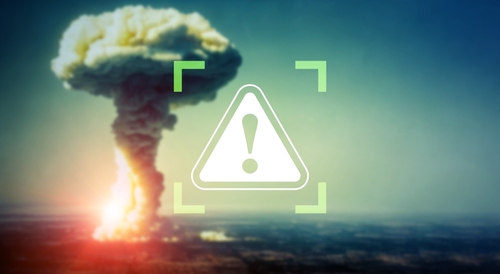America’s nuclear defenses face a new kind of intrusion as mystery drones breach a military base believed to store US nuclear weapons—raising urgent questions about national security and exposing vulnerabilities that demand immediate action.
Drones Penetrate Nuclear Base Security, Sparking Alarm
Over a span of just 24 hours, several drones were spotted flying perilously close to a military base believed to house US nuclear weapons. On the first day, drones triggered security alerts and drew gunfire as they hovered near the perimeter, while the following day saw additional UAVs breach even closer—within a few hundred meters of highly sensitive facilities. The repeated nature of these incursions signals an alarming escalation, prompting immediate concern among defense officials and international agencies. As these unmanned vehicles grow more sophisticated, traditional security measures—once thought sufficient—are increasingly challenged, exposing critical gaps in America’s nuclear safety protocols.
The International Atomic Energy Agency (IAEA) responded swiftly, issuing warnings and requesting access to inspect the site for possible vulnerabilities. Such visits are not always granted, reflecting the sensitive nature of these locations. The IAEA’s Director General Rafael Mariano Grossi emphasized, “Too many drones flying near nuclear sites… It should stop immediately,” underscoring the gravity of the situation. The agency also called for maximum military restraint around nuclear facilities, aiming to prevent any scenario that could put nuclear assets—and American communities—at risk.
Threats Intensify Amid Global Unrest and Technological Advances
Drone attacks on military and nuclear facilities have surged in recent years, fueled by global conflicts and rapid advances in UAV technology. The proliferation of affordable, commercially available drones means non-state actors, adversarial nations, and even rogue individuals can now threaten America’s most strategic sites. Russia’s invasion of Ukraine in 2022 triggered a spike in drone incidents around nuclear power plants, and recent months have seen similar tactics deployed near US and NATO bases. These incursions are not isolated; April 2025 saw a drone shot down near Zaporizhzhia’s training center, while September brought 22 drones near the South Ukraine Nuclear Power Plant. The convergence of conflict zones and technological leaps is testing the limits of America’s defense posture and raising the stakes for constitutional protections and national sovereignty.
As the Trump administration works to restore order and reinforce America’s defenses, these incidents serve as a stark reminder of the ongoing need to adapt security protocols to new threats. The base in question remains under tight surveillance and heightened security, but experts warn that more must be done to counter the evolving tactics of drone operators—whose identities and motives remain shrouded in uncertainty. Some analysts believe these incursions could be driven by intelligence gathering, sabotage, or testing of defensive systems, while others see them as symptoms of broader geopolitical instability. Regardless, the repeated and brazen nature of these attacks demands a unified response grounded in both technological innovation and strong constitutional principles.
Escalating Risks Require Urgent Action and New Countermeasures
Immediate impacts from the drone incursions include heightened security alerts, activation of emergency protocols, and temporary shutdowns of critical operations at affected nuclear sites. While no major damage or casualties have been reported to date, the persistent risk of catastrophic incidents looms large. In the longer term, these attacks threaten not only the safety of local communities near nuclear facilities but also the stability of the international order. Economic costs from emergency responses and potential cleanups could soar, while social anxiety and political tensions continue to escalate. The nuclear industry now faces increased regulatory scrutiny, and the drone technology sector may soon encounter new restrictions and mandatory countermeasures to address these evolving threats.
🚨Mystery drones over Belgium’s most sensitive air base again.
For the second night in a row, unidentified drones breached restricted airspace above Kleine-Brogel, the NATO base rumored to store U.S. nuclear weapons.
A dronegun jammer was fired and failed. The craft escaped… pic.twitter.com/ewJ73r3WwT
— Skywatch Signal (@UAPWatchers) November 2, 2025
Industry experts and military analysts are unanimous in their warnings: traditional air defenses are largely inadequate against small, agile drones. The IAEA and nuclear safety scholars advocate for rapid development of detection and neutralization technologies, as well as stronger cooperation between agencies tasked with securing America’s most sensitive assets. Technology professionals highlight the urgent need for innovative counter-drone systems—capable of identifying, intercepting, and disabling suspicious UAVs before they reach critical sites. These recommendations reflect a broader consensus that the threat landscape is changing, and only proactive measures can protect the nation’s nuclear deterrence and constitutional values from erosion.
Sources:
IAEA warning over drones near nuclear sites


Get a big pair of choppers carrying a cargo net and sweep the sky of drones.. then you have something to analyze